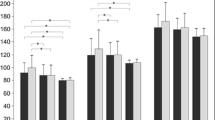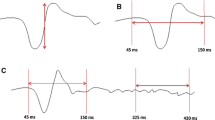Abstract
The detection of hidden visual loss is important in establishing the diagnosis of multiple sclerosis, especially in patients who have neurologic symptoms of the disease. Both visual evoked potentials and contrast sensitivity have been used for this purpose. We compared the sensitivities of pattern-reversal visual evoked potentials and contrast sensitivity, measured with the Vistech VCTS 6500 chart, in detecting hidden visual loss in 18 patients with multiple sclerosis whose visual acuity was correctable to 20/20 (6/6) or better in the examined eye. Thirteen patients had delayed visual evoked potential latencies. An additional four patients had reduced P100 amplitudes without prolonged latencies. Nine patients had abnormal contrast sensitivity. The visual evoked potential was more sensitive than contrast sensitivity at detecting hidden visual loss in patients with multiple sclerosis (p < 0.01).
Similar content being viewed by others
Abbreviations
- MS:
-
multiple sclerosis
- ON:
-
optic neuritis
References
Halliday AM, McDonald WI, Mushin J. Delayed visual evoked response in optic neuritis. Lancet 1972: i: 982–85.
Plant GT, Hess RF. The electrophysiological assessment of optic neuritis. In: Hess RF, Plant GT, eds. Optic neuritis. Cambridge, UK: Cambridge University Press, 1977: 192–229.
Plant GT, Hess RF. The psychophysical loss in optic neuritis: spatial and temporal aspects. In: Hess RF, Plant GT, eds. Optic neuritis. Cambridge, UK: Cambridge University Press, 1977: 109–85.
Regan D, Silver R, Murray TJ. Visual acuity and contrast sensitivity in multiple sclerosis: hidden visual loss. Brain 1977; 100: 563–79.
Wildberger H. Retrobubar Neuritis und visuell evozierte Potentiale. Klin Monatsbl Augenheilkd 1976; 168: 98–100.
Hoeppner T. Lolas F. Visual evoked responses and visual symptoms in multiple sclerosis. J Neurol Neurosurg Psychiatry 1978; 41: 493–98.
Poel JC Van der. Visual function in optic neuritis in relation to multiple sclerosis: an electrophysiological and psychophysical study. Doctoral Thesis. Erasmus University, Rotterdam, The Netherlands. Baarn, The Netherlands: Bosch and Keuning, 1985.
Wall M, Dalali M. Contrast sensitivity, color vision and perimetry in 100 examinations of patients with optic neuropathies and normal Snellen acuity. In: Heijl A, ed. Perimetry Update 1988/89. Proceedings of the 8th International Perimetric Society Meeting. Amsterdam: Kugler & Ghedini Publications, 1989: 59–65.
Fleishman JA, Beck RW, Linares OA, Klein JW. Deficits in visual function after resolution of optic neuritis. Ophthalmology 1987; 94: 1029–35.
Beck RJ, Ruchman MC, Savino PJ, Schatz NJ. Contrast sensitivity measurements in acute and resolved optic neuritis. Br J Ophthalmol 1984; 68: 756–59.
Lennerstrand G, Stendahl-Brodin L. Pattern VEP in two immunochemical subtypes of optic neuritis. Acta Ophthalmol 1982; 60: 313–24.
Weinstein GW, Odom JV, Cavender S. Visually evoked potentials and electroretinography in neurological evaluation. Neurol Clin 1991; 9: 225–41.
Ginsburg AP. A new contrast sensitivity vision test chart. Am J Optom Physiol Opt 1984; 61: 403–7.
Leys MJJ, Candaele CMLJ, Uvijls AGV, Heintz BF, de Rouck AF, Odom JV. The detection of hidden visual loss in optic neuropathy. Vistech test at variable illuminations. Bull Soc Belge Ophtalmol 1990; 236; 55–64.
Van Norren D, Groenenberg H, Varkevisser J, Boogaard J. Examination of contrast sensitivity. Soesterberg, The Netherlands: TNO Institute for Perception. (Report IZF 1986-38).
Kupersmith MJ, Nelson JI, Seiple WH, Carr RE, Weiss PA. The 20/20 eye in multiple sclerosis. Neurology 1983; 33: 1015–20.
Nordmann JP, Saraux H, Roullet E. Contrast sensitivity in multiple sclerosis: a study in 35 patients with and without optic neuritis. Ophthalmologica 1987; 195: 199–204.
Rubin GS. Reliability and sensitivity of clinical contrast sensitivity tests. Clin Vis Sci 1988; 2: 169–77.
Brown B, Lovie-Kitchin JE. High and low contrast acuity and clinical contrast sensitivity tested in a normal population. Optom Vis Sci 1989; 66: 467–73.
Halliday AM. Event-related potentials and their diagnostic usefulness. In: Deecke L, Kornhuber HH, eds. Motivation, motor and sensory processes of the brain. Electrical potentials, behavior and clinical use. [Prog in Brain Res, Vol. 54]. 1980: 469–85.
Spekreijse H, Duwaer AL, Posthumus Meyjes FE. Contrast evoked potentials and psychophysics in multiple sclerosis patients. In: Lehmann D, Callaway E, eds. Human evoked potentials. New York: Plenum, 1979: 363–81.
Marx MS, May JG, Reed JL, Matteson HH, van Dyk HJL, Jayaraman A. Spatial temporal processing in multiple sclerosis. Doc Ophthalmol 1984; 56: 243–64.
Urbach D, Gur M, Pratt H, Peled R. Time domain analysis of VEPs: detection of waveform abnormalities in multiple sclerosis. Invest Ophthalmol Vis Sci 1986; 27: 1379–84.
Trick GL, Trobe JD, Dawson WW, Trick LR, McFadden C. Power spectral analysis of visual evoked potentials in multiple sclerosis. Curr eye Res 1984; 3: 1179–86.
Warman RO, Glaser JS. Comparison of optotype contrast sensitivity and visual evoked potentials in optic nerve disease. Neuro-ophthalmology 1989; 9: 195–202.
Author information
Authors and Affiliations
Additional information
on leave from the Department of Ophthalmology, West Virginia University Health Sciences Center, Morgantown, WVa, USA
Rights and permissions
About this article
Cite this article
Leys, M.J.J., Candaele, C.M.L.J., De Rouck, A.F. et al. Detection of hidden visual loss in multiple sclerosis. Doc Ophthalmol 77, 255–264 (1991). https://doi.org/10.1007/BF00161372
Accepted:
Issue Date:
DOI: https://doi.org/10.1007/BF00161372




